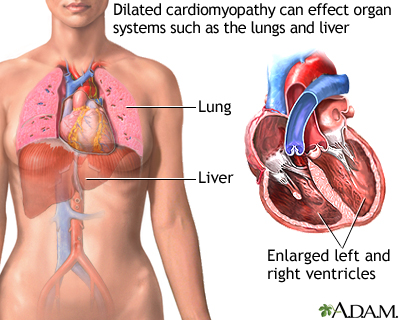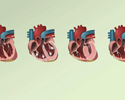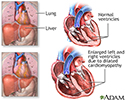Dilated cardiomyopathy
Cardiomyopathy - dilated; Primary cardiomyopathy; Diabetic cardiomyopathy; Idiopathic cardiomyopathy; Alcoholic cardiomyopathy
Cardiomyopathy is disease in which the heart muscle becomes weakened, stretched, or has another structural problem.
Dilated cardiomyopathy is a condition in which the heart muscle becomes weakened and enlarged. As a result, the heart cannot pump enough blood to the rest of the body.
There are many types of cardiomyopathy. Dilated cardiomyopathy is the most common form.
Causes
The most common causes of dilated cardiomyopathy are:
- Heart disease caused by a narrowings or blockages of the coronary arteries
- Poorly controlled high blood pressure
There are many other causes of dilated cardiomyopathy, including:
- Alcohol or cocaine abuse
- Diabetes, thyroid disease, or hepatitis
- Medicines that can be toxic to the heart, such as drugs used to treat cancer
- Abnormal heart rhythms in which the heart beats very fast for a long period of time
-
Autoimmune illnesses
Autoimmune illnesses
An autoimmune disorder occurs when the body's immune system attacks and destroys healthy body tissue by mistake. There are more than 80 types of aut...
 ImageRead Article Now Book Mark Article
ImageRead Article Now Book Mark Article - Conditions that run in families
-
Infections that involve the heart muscle
Infections that involve the heart muscl
Myocarditis is inflammation of the heart muscle. The condition is called pediatric myocarditis when it occurs in children.
 ImageRead Article Now Book Mark Article
ImageRead Article Now Book Mark Article - Heart valves that are either too narrow or too leaky
-
During the last month of pregnancy, or
within 5 months after the baby is born
.
Within 5 months after the baby is born
Peripartum cardiomyopathy is a rare disorder in which a pregnant woman's heart becomes weakened and enlarged. It develops during the last month of p...
 ImageRead Article Now Book Mark Article
ImageRead Article Now Book Mark Article - Exposure to heavy metals such as lead, arsenic, cobalt, or mercury
This condition can affect anyone at any age. However, it is most common in adult men.
Symptoms
Symptoms of heart failure are most common. They most often develop slowly over time. However, sometimes symptoms start very suddenly and are severe.
Common symptoms are:
- Chest pain or pressure (more likely with exercise)
- Cough
- Fatigue, weakness, faintness
- Irregular or rapid pulse
- Loss of appetite
-
Shortness of breath
with activity or after lying down (or being asleep) for a while
Shortness of breath
Breathing difficulty may involve:Difficult breathingUncomfortable breathingFeeling like you are not getting enough air
 ImageRead Article Now Book Mark Article
ImageRead Article Now Book Mark Article -
Swelling of feet
and ankles
Swelling of feet
Painless swelling of the feet and ankles is a common problem, especially among older people. Abnormal buildup of fluid in the ankles, feet, and legs ...
 ImageRead Article Now Book Mark Article
ImageRead Article Now Book Mark Article
Exams and Tests
During the exam, the health care provider may find:
- The heart is enlarged.
- Lung crackles (a sign of fluid buildup), heart murmur, or other abnormal sounds.
- The liver is possibly enlarged.
- Neck veins may be bulging.
A number of laboratory tests may be done to determine the cause:
-
Antinuclear antibody (
ANA
), erythrocyte sedimentation rate (
ESR
), and other tests to diagnose autoimmune illnesses
ANA
The antinuclear antibody panel is a blood test that looks at antinuclear antibodies (ANA). ANA are substances produced by the immune system that atta...
 ImageRead Article Now Book Mark Article
ImageRead Article Now Book Mark ArticleESR
ESR stands for erythrocyte sedimentation rate. It is commonly called a "sed rate. "It is a test that indirectly measures how much inflammation is in...
Read Article Now Book Mark Article - Antibody test to identify infections such as Lyme disease and HIV
- Iron tests of the blood
-
Serum
TSH
and
T4
test to identify thyroid problems
TSH
A TSH test measures the amount of thyroid stimulating hormone (TSH) in your blood. TSH is produced by the pituitary gland. It tells the thyroid gla...
 ImageRead Article Now Book Mark Article
ImageRead Article Now Book Mark ArticleT4
T4 (thyroxine) is the main hormone produced by the thyroid gland. A laboratory test can be done to measure the amount of free T4 in your blood....
 ImageRead Article Now Book Mark Article
ImageRead Article Now Book Mark Article -
Tests for
amyloidosis
Amyloidosis
Cardiac amyloidosis is a disorder caused by deposits of an abnormal protein (amyloid) in the heart tissue. These deposits make it hard for the heart...
 ImageRead Article Now Book Mark Article
ImageRead Article Now Book Mark Article
Heart enlargement or other problems with the structure and function of the heart (such as weak squeezing) may show up on these tests. They may also help diagnose the exact cause of the problem:
-
Echocardiogram
(ultrasound of the heart)
Echocardiogram
An echocardiogram is a test that uses sound waves to create pictures of the heart. The picture and information it produces is more detailed than a s...
 ImageRead Article Now Book Mark Article
ImageRead Article Now Book Mark Article -
Cardiac stress tests
Cardiac stress tests
Stress echocardiography is a test that uses ultrasound imaging to show how well your heart muscle is working to pump blood to your body. It is most ...
 ImageRead Article Now Book Mark Article
ImageRead Article Now Book Mark Article -
Chest x-ray
Chest x-ray
A chest x-ray is an x-ray of the chest, lungs, heart, large arteries, ribs, and diaphragm.
 ImageRead Article Now Book Mark Article
ImageRead Article Now Book Mark Article -
Coronary angiogram
to look at blood flow to the heart
Coronary angiogram
Coronary angiography is a procedure that uses a special dye (contrast material) and x-rays to see how blood flows through the arteries in your heart....
 ImageRead Article Now Book Mark Article
ImageRead Article Now Book Mark Article -
CT scan of the heart
CT scan of the heart
A computed tomography (CT) scan of the heart is an imaging method that uses x-rays to create detailed pictures of the heart and its blood vessels. Th...
 ImageRead Article Now Book Mark Article
ImageRead Article Now Book Mark Article -
MRI of the heart
MRI of the heart
Heart magnetic resonance imaging is an imaging method that uses powerful magnets and radio waves to create pictures of the heart. It does not use ra...
 ImageRead Article Now Book Mark Article
ImageRead Article Now Book Mark Article -
Nuclear heart scan
(MUGA, RNV)
Nuclear heart scan
Nuclear ventriculography is a test that uses radioactive materials called tracers to show the heart chambers. The procedure is noninvasive. The ins...
 ImageRead Article Now Book Mark Article
ImageRead Article Now Book Mark Article
Heart biopsy , in which a small piece of heart muscle is removed, may be needed depending on the cause. However, this is rarely done.
Heart biopsy
Myocardial biopsy is the removal of a small piece of heart muscle for examination.

Treatment
Things you can do at home to take care of your condition include:
-
Know your body, and watch for symptoms that your
heart failure
is getting worse.
Heart failure
Heart failure is a condition in which the heart is no longer able to pump oxygen-rich blood to the rest of the body efficiently. This causes symptom...
 ImageRead Article Now Book Mark Article
ImageRead Article Now Book Mark Article - Watch for changes in your symptoms, heart rate, pulse, blood pressure, and weight.
-
Limit
how much you drink
and
how much salt (sodium)
you get in your diet.
How much you drink
HF - fluids and diuretics; CHF - ICD discharge; Cardiomyopathy - ICD discharge
Read Article Now Book Mark Article
Most people who have heart failure need to take medicines . Some medicines treat your symptoms. Others may help prevent your heart failure from becoming worse, or may prevent other heart problems.
Heart failure need to take medicines
CHF - medicines; Congestive heart failure - medicines; Cardiomyopathy - medicines; HF - medicines
Procedures and surgeries you may need include:
- A pacemaker to help treat slow heart rates or help your heartbeat stay in sync
- A defibrillator that recognizes life-threatening heart rhythms and sends an electrical pulse to stop them
-
Heart bypass
(CABG) surgery or angioplasty to improve blood flow to the damaged or weakened heart muscle
Heart bypass
Heart bypass surgery creates a new route, called a bypass, for blood and oxygen to go around a blockage to reach your heart.
 ImageRead Article Now Book Mark Article
ImageRead Article Now Book Mark Article - Valve replacement or repair
For advanced cardiomyopathy:
- A heart transplant may be recommended if standard treatments have not worked and heart failure symptoms are very severe.
-
Placement of a
left ventricular assist device
or artificial heart may be considered.
Left ventricular assist device
Ventricular assist devices (VADs) help your heart pump blood from one of the main pumping chambers to the rest of your body or to the other side of t...
 ImageRead Article Now Book Mark Article
ImageRead Article Now Book Mark Article
Chronic heart failure becomes worse over time. Many people who have heart failure will die from the condition. Thinking about the type of care you may want at the end of life and discussing these issues with loved ones and your health care provider is important.
Care you may want at the end of life
CHF - palliative; Congestive heart failure - palliative; Cardiomyopathy - palliative; HF - palliative; Cardiac cachexia; End-of-life-heart failure...
Outlook (Prognosis)
Heart failure is most often a chronic illness, which may get worse over time. Some people develop severe heart failure, in which medicines, other treatments, and surgery no longer help. Many people are at risk for deadly heart rhythms, and may need medicines or a defibrillator.
When to Contact a Medical Professional
Call your provider if you have symptoms of cardiomyopathy.
Get emergency medical help right away if you have chest pain, palpitations or fainting.
References
Falk RH, Hershberger RE. The dilated, restrictive, and infiltrative cardiomyopathies In: Mann DL, Zipes DP, Libby P, Bonow RO, Braunwald E, eds. Braunwald's Heart Disease: A Textbook of Cardiovascular Medicine . 10th ed. Philadelphia, PA: Elsevier Saunders; 2015:chap 65.
Mckenna WJ, Elliott P. Diseases of the myocardium and endocardium. In: Goldman L, Schafer AI, eds. Goldman's Cecil Medicine . 25th ed. Philadelphia, PA: Elsevier Saunders; 2016:chap 60.
-
Cardiomyopathy overview
Animation
-
Heart, section through the middle - illustration
The interior of the heart is composed of valves, chambers, and associated vessels.
Heart, section through the middle
illustration
-
Heart, front view - illustration
The external structures of the heart include the ventricles, atria, arteries and veins. Arteries carry blood away from the heart while veins carry blood into the heart. The vessels colored blue indicate the transport of blood with relatively low content of oxygen and high content of carbon dioxide. The vessels colored red indicate the transport of blood with relatively high content of oxygen and low content of carbon dioxide.
Heart, front view
illustration
-
Dilated cardiomyopathy - illustration
Dilated cardiomyopathy involves enlargement of the heart muscle and is the most common type of cardiomyopathy. The heart muscle is weakened and cannot pump blood efficiently. Decreased heart function affects the lungs, liver, and other body systems.
Dilated cardiomyopathy
illustration
-
Alcoholic cardiomyopathy - illustration
Excessive use of alcohol has a direct toxic effect on the heart muscle cells. The heart muscle becomes weakened and cannot pump blood efficiently. The lack of blood flow affects all parts of the body, resulting in damage to multiple tissues and organ systems. Alcohol may also directly damage the liver.
Alcoholic cardiomyopathy
illustration
-
Heart, section through the middle - illustration
The interior of the heart is composed of valves, chambers, and associated vessels.
Heart, section through the middle
illustration
-
Heart, front view - illustration
The external structures of the heart include the ventricles, atria, arteries and veins. Arteries carry blood away from the heart while veins carry blood into the heart. The vessels colored blue indicate the transport of blood with relatively low content of oxygen and high content of carbon dioxide. The vessels colored red indicate the transport of blood with relatively high content of oxygen and low content of carbon dioxide.
Heart, front view
illustration
-
Dilated cardiomyopathy - illustration
Dilated cardiomyopathy involves enlargement of the heart muscle and is the most common type of cardiomyopathy. The heart muscle is weakened and cannot pump blood efficiently. Decreased heart function affects the lungs, liver, and other body systems.
Dilated cardiomyopathy
illustration
-
Alcoholic cardiomyopathy - illustration
Excessive use of alcohol has a direct toxic effect on the heart muscle cells. The heart muscle becomes weakened and cannot pump blood efficiently. The lack of blood flow affects all parts of the body, resulting in damage to multiple tissues and organ systems. Alcohol may also directly damage the liver.
Alcoholic cardiomyopathy
illustration
Review Date: 2/24/2016
Reviewed By: Michael A. Chen, MD, PhD, Associate Professor of Medicine, Division of Cardiology, Harborview Medical Center, University of Washington Medical School, Seattle, WA. Also reviewed by David Zieve, MD, MHA, Isla Ogilvie, PhD, and the A.D.A.M. Editorial team.







